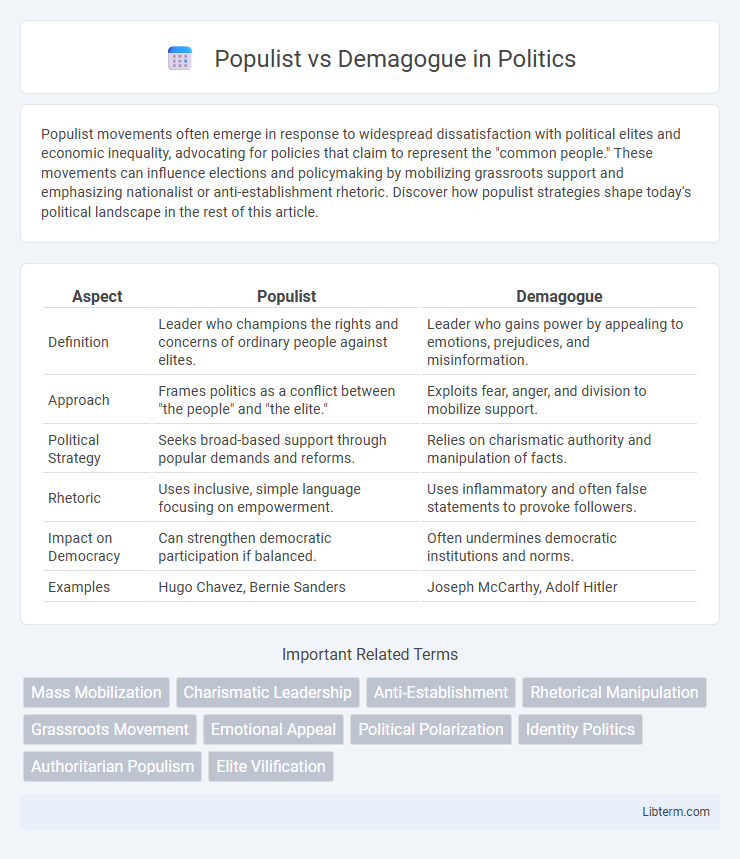Populist movements often emerge in response to widespread dissatisfaction with political elites and economic inequality, advocating for policies that claim to represent the "common people." These movements can influence elections and policymaking by mobilizing grassroots support and emphasizing nationalist or anti-establishment rhetoric. Discover how populist strategies shape today's political landscape in the rest of this article.
Table of Comparison
| Aspect | Populist | Demagogue |
|---|---|---|
| Definition | Leader who champions the rights and concerns of ordinary people against elites. | Leader who gains power by appealing to emotions, prejudices, and misinformation. |
| Approach | Frames politics as a conflict between "the people" and "the elite." | Exploits fear, anger, and division to mobilize support. |
| Political Strategy | Seeks broad-based support through popular demands and reforms. | Relies on charismatic authority and manipulation of facts. |
| Rhetoric | Uses inclusive, simple language focusing on empowerment. | Uses inflammatory and often false statements to provoke followers. |
| Impact on Democracy | Can strengthen democratic participation if balanced. | Often undermines democratic institutions and norms. |
| Examples | Hugo Chavez, Bernie Sanders | Joseph McCarthy, Adolf Hitler |
Understanding Populism: Core Principles
Populism centers on appealing to the interests and perceptions of the general population, emphasizing a clear distinction between "the people" and "the elite." Core principles include advocating for direct representation and often positioning political power as a tool for the majority against established institutions. This contrasts with demagoguery, which manipulates popular desires and prejudices through emotional appeals rather than genuine policy solutions.
Defining Demagoguery: Tactics and Traits
Demagoguery involves exploiting popular desires and fears through manipulative rhetoric and emotional appeals, often disregarding rational debate or factual accuracy. Demagogues employ tactics such as scapegoating, oversimplifying complex issues, and appealing to nationalism or prejudice to gain power and influence. Traits defining demagogues include charismatic leadership, intolerance of dissent, and a tendency to incite division to consolidate authority.
Historical Roots of Populist Movements
Populist movements trace their historical roots to the late 19th century, notably with the People's Party in the United States, which advocated for agrarian interests and economic reforms against industrial elites. These movements often arise during periods of social upheaval and economic inequality, leveraging widespread discontent to mobilize mass support. Unlike demagogues who exploit emotions for personal power, early populists sought systemic change through collective action and political reforms.
Demagogues in History: Notable Examples
Demagogues in history manipulated public emotions and prejudices to gain power, exploiting social divisions for personal or political gain. Notable examples include Adolf Hitler, who used nationalist rhetoric to incite hatred and consolidate authoritarian control in Nazi Germany, and Joseph McCarthy, whose anti-Communist crusade fueled widespread fear and repression in 1950s America. These figures demonstrate how demagogues leverage propaganda and mass appeal to undermine democratic institutions and spread intolerance.
Populist Leaders vs Demagogues: Key Differences
Populist leaders emphasize representing the common people's interests against established elites by promoting inclusive policies and direct communication. Demagogues manipulate popular desires and prejudices to gain power, often using fear, misinformation, and divisive rhetoric. The key difference lies in intent and methods, where populists seek genuine reform while demagogues prioritize personal power through emotional manipulation.
Rhetorical Strategies: Populist vs Demagogue
Populists employ inclusive rhetoric aimed at uniting "the people" against perceived elites, often using simple, relatable language to create a sense of collective identity. Demagogues utilize fear-mongering and scapegoating, emphasizing emotional appeals and exaggerating threats to manipulate public opinion. Both use persuasive techniques, but populists seek broad appeal through shared grievances, while demagogues focus on divisive and inflammatory messaging to consolidate power.
Impact on Democracy: Populism and Demagoguery
Populism often seeks to empower ordinary people by challenging elite control, but it can risk oversimplifying complex issues and undermining institutional checks and balances. Demagoguery exploits popular desires and fears through emotional appeals and misinformation, usually eroding democratic norms and fostering division. Both phenomena impact democracy by influencing public trust, political polarization, and the stability of democratic governance.
Public Perception: Media and Political Narratives
Public perception of populists and demagogues is heavily shaped by media framing and political narratives, which emphasize distinct characteristics such as populists' appeal to common people's grievances versus demagogues' use of manipulative rhetoric and fearmongering. Media portrayals often influence voters by highlighting populists as champions of the marginalized, while demagogues are depicted as threats to democratic norms. Political narratives strategically leverage these perceptions to mobilize support or discredit opponents, affecting the overall legitimacy and influence of each figure.
Modern-Day Populists and Demagogues
Modern-day populists often position themselves as champions of ordinary people against perceived elite establishments, using inclusive rhetoric to mobilize broad support. Demagogues exploit fear and prejudice, employing divisive language and misinformation to manipulate public opinion and consolidate power. The distinction lies in populists' appeal to popular will versus demagogues' tactics of emotional manipulation and scapegoating.
Safeguarding Democracy: Lessons and Solutions
Populist leaders often mobilize public support by addressing widespread grievances, but safeguarding democracy requires distinguishing this from demagoguery, which exploits fears and misinformation to undermine institutions. Effective solutions include strengthening independent media, promoting civic education, and implementing robust checks and balances to prevent abuse of power. Lessons from democratic backsliding emphasize the importance of transparency, accountability, and protecting minority rights to maintain democratic resilience.
Populist Infographic

 libterm.com
libterm.com